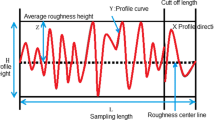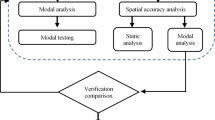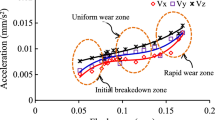Abstract
In this study, structural performance analysis and test verification of a machine tool were performed. This research is based on a five-axis machine tool for modeling and experimental verification. The mechanical-structure performance of the machine-tool cutting process directly affects the processing results. The processing performance of a five-axis machine tool was analyzed to identify processing weaknesses as the basis for subsequent structural improvements. Data were then integrated through the abductory induction mechanism (AIM) polynomial neural network to predict intelligent processing quality, and an in-depth investigation was conducted by importing processing parameters to predict the surface quality of the finished product. The finite-element analysis method was used to analyze the static and dynamic characteristics of the whole machine and to test the structural modal frequency and vibration shape. For modal testing, the experiment used various equipment, including impact hammers, accelerometers, and signal extractors. Subsequent planning of modal frequency band processing experiments was conducted to verify the influence of natural frequencies on the processing level. Finally, according to the machine processing characteristics, a processing experiment was planned. The measurement record was used as the training data of the AIM polynomial neural network to establish the processing quality prediction model. After analysis and an actual machine test comparison, the two-axis static rigidity values of the machine were X: 1.63 kg/µm and Y: 1.93 kg/µm. The modal vibration shape maximum error of the machine was within 6.2%. The processing quality prediction model established by the AIM polynomial neural network could input processing parameters to achieve the surface roughness prediction value, and the actual relative error of the Ra value was within 0.1 µm. Based on the results of cutting experiments, the influence of the dynamic characteristics of the machine on the processing quality was obtained, especially in the modal vibration environment, which had an adverse effect on the surface roughness. Hence, the surface roughness of the workpiece processed by the machine could be predicted.











Similar content being viewed by others
Abbreviations
- CPM:
-
Complexity penalty factor
- FSE:
-
Fitting squared error
- KP:
-
Complexity penalty
- PSE:
-
Predicted squared error
References
Eynian M (2019) In-process identification of modal parameters using dimensionless relationships in milling chatter. Int J Mach Tools Manuf 143:49–62
Tang X, Peng F, Yan R, Zhu Z, Li Z, Xin S (2021) Nonlinear process damping identification using finite amplitude stability and the influence analysis on five-axis milling stability. Int J Mech Sci 190:106008
Liu H, Wu J, Liu K, Kuang K, Luo Q, Liu Z, Wang Y (2019) Pretightening sequence planning of anchor bolts based on structure uniform deformation for large CNC machine tools. Int J Mach Tools Manuf 136:1–18
Muñoz-Escalonaa P, Maropoulosb PG (2015) A geometrical model for surface roughness prediction when face milling Al 7075–T7351 with square insert tools. J Manuf Syst 36:216–223
Zhao Z, Wang S, Wang Z, Liu N, Wang S, Ma C, Yang B (2020) Interference- and chatter-free cutter posture optimization towards minimal surface roughness in five-axis machining. Int J Mech Sci 171:105395
Wang L, Ge S, Si H, Yuan X, Duan F (2020) Roughness control method for five-axis flank milling based on the analysis of surface topography. Int J Mech Sci 169:105337
Wang L, Ge S, Si H, Guan L, Duan F, Liu Y (2020) Elliptical model for surface topography prediction in five-axis flank milling. Chin J Aeronaut 33(4):1361–1374
Tomov M, Kuzinovski M, Cichosz P (2016) Development of mathematical models for surface roughness parameter prediction in turning depending on the process condition. Int J Mech Sci 113:120–132
Das B, Roy S, Rai RN, Saha SC (2016) Study on machinability of in situ Al–4.5%Cu–TiC metal matrix composite-surface finish, cutting force prediction using ANN. CIRP J Manuf Sci Technol 12:67–78
García-Plaza E, Núñez Lópeza PJ, Beamud Gonzálezb EM (2019) Efficiency of vibration signal feature extraction for surface finish monitoring in CNC machining. J Manuf Process 44:145–157
Rasagopal P, Senthilkumar P, Nallakumarasamy G, Magibalan S (2020) A study surface integrity of aluminum hybrid composites during milling peration. J Market Res 9(3):4884–4893
Mansour A, Abdalla H (2002) Surface roughness model for end milling: a semi-free cutting carbon casehardening steel (EN32) in dry condition. J Mater Process Technol 124:183–191
Abouelatta OB, Mádl J (2001) Surface roughness prediction based on cutting parameters and tool vibrations in turning operations. J Mater Process Technol 118(1–3):269–277
Lin WS, Lee BY, Wu CL (2001) Modeling the surface roughness and cutting force for turning. J Mater Process Technol 108:286–293
Ostasevicius V, Gaidys R, Rimkeviciene J, Dauksevicius R (2010) An approach based on tool mode control for surface roughness reduction in high-frequency vibration cutting. J Sound Vib 329:4866–4879
Sahin Y, Motorcu AR (2008) Surface roughness model in machining hardened steel with cubic boron nitride cutting tool. Int J Refract Metal Hard Mater 26:84–90
Öktem H, Erzurumlu T, Kurtaran H (2005) Application of response surface methodology in the optimization of cutting conditions for surface roughness. J Mater Process Technol 170:11–16
Lalwani DI, Mehta NK, Jain PK (2008) Experimental investigations of cutting parameters influence on cutting forces and surface roughness in finish hard turning of MDN250 steel. J Mater Process Technol 206:167–179
Davim JP, Gaitonde VN, Karnikc SR (2008) Investigations into the effect of cutting conditions on surface roughness in turning of free machining steel by ANN models. J Mater Process Technol 205:16–23
Liu N, Wang SB, Zhang YF, Lu WF (2016) A novel approach to predicting surface roughness based on specific cutting energy consumption when slot milling Al-7075. Int J Mech Sci 118:13–20
Diniz AE, Micaroni R (2002) Cutting conditions for finish turning process aiming: the use of dry. Int J Mach Tools Manuf 42:899904
Muthukrishnan N, Davim JP (2009) Optimization of machining parameters of Al/SiC-MMC with ANOVA and ANN analysis. J Mater Process Technol 209:225–232
Rawangwong S, Chatthong J, Boonchouytan W, Burapa R (2014) Influence of cutting parameters in face milling semi-solid AA7075 using carbide tool affected the surface roughness and tool wear. Energy Procedia 56:448–457
Wang YC, Chen CH, Lee BY (2009) The predictive model of surface roughness and searching system in database for cutting tool grinding. Mater Sci Forum 626–627:11–16
Chen J-Y, Chan T-C, Lee B-Y, Liang C-Y (2020) Prediction model of cutting edge for end mills based on mechanical material properties. Int J Adv Manuf Technol 107:2939–2951
Funding
The authors are greatly indebted to the Ministry of Science and Technology of the R.O.C. for supporting this research (Grant No. MOST 107–2218-E-150–005-MY3 and MOST 109–2622-E-150–014).
Author information
Authors and Affiliations
Contributions
Formal analysis, writing, and funding acquisition, T-CC; data curation, and software H-HL and SVVSR. All authors read and agreed to the published version of the manuscript.
Corresponding author
Ethics declarations
Conflicts of interest
The authors declare no competing interests.
Additional information
Publisher's note
Springer Nature remains neutral with regard to jurisdictional claims in published maps and institutional affiliations.
Rights and permissions
About this article
Cite this article
Chan, TC., Lin, HH. & Reddy, S.V.V.S. Prediction model of machining surface roughness for five-axis machine tool based on machine-tool structure performance. Int J Adv Manuf Technol 120, 237–249 (2022). https://doi.org/10.1007/s00170-021-08634-7
Received:
Accepted:
Published:
Issue Date:
DOI: https://doi.org/10.1007/s00170-021-08634-7




